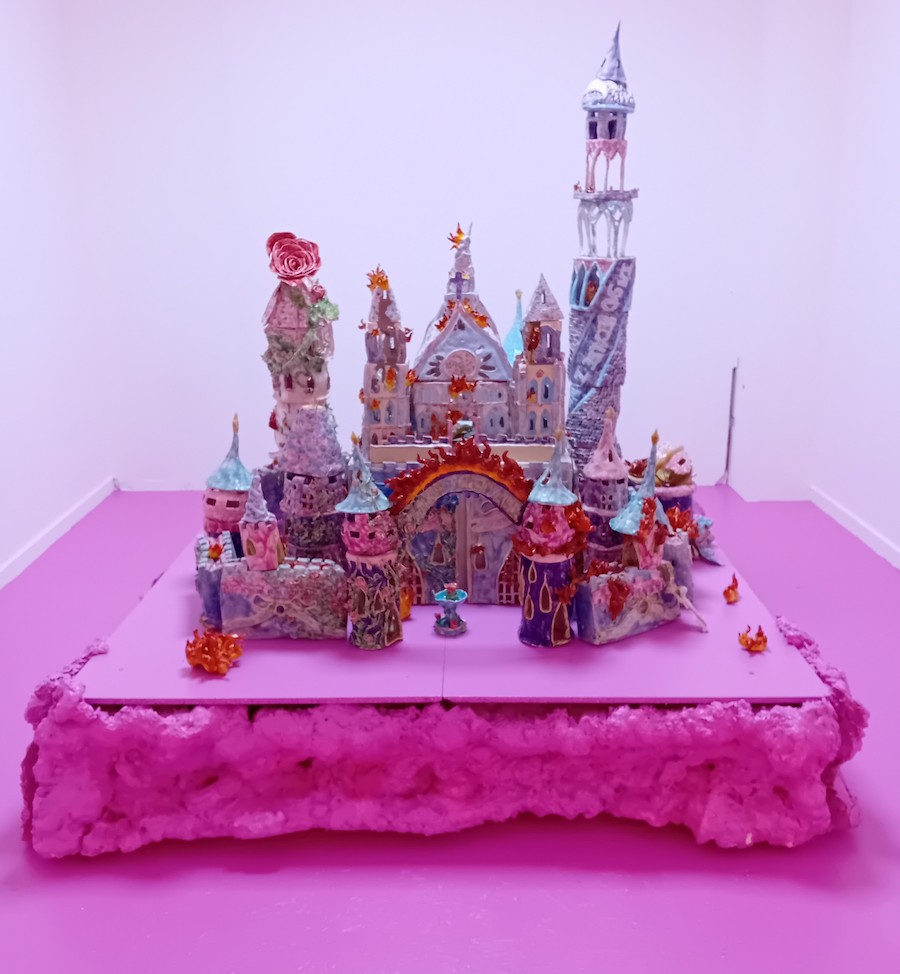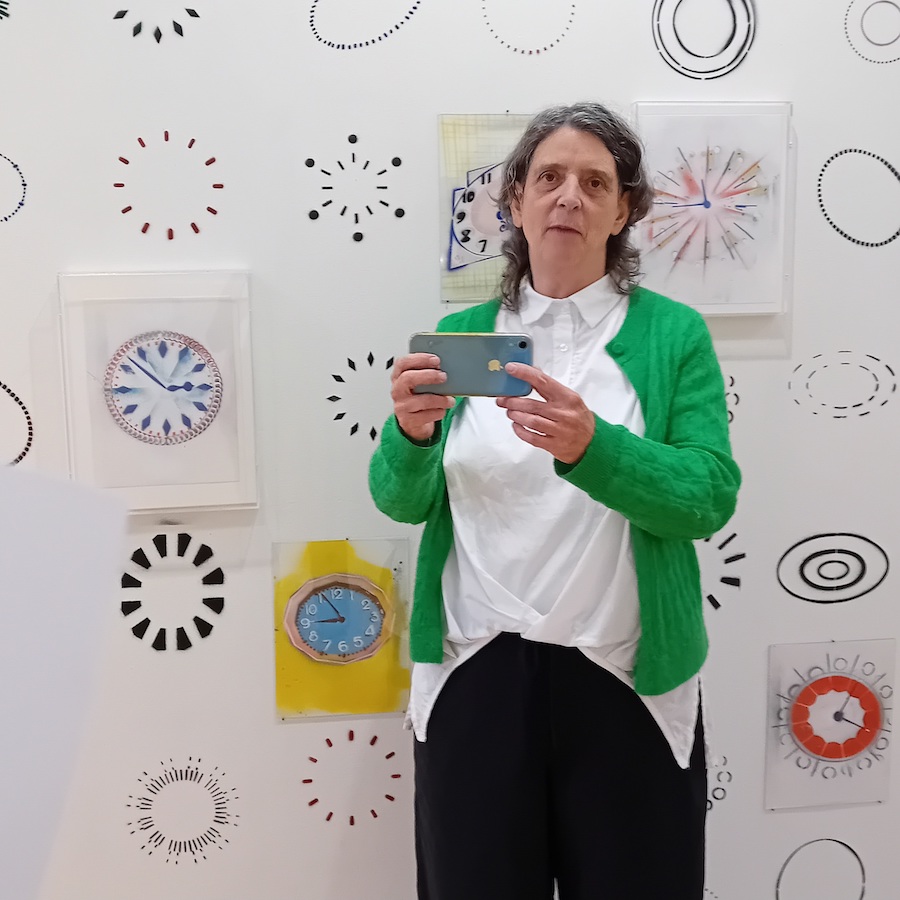The 12th Amsterdam Art Week officially ran 29 May – 2 June, but most of its shows carry on longer – in 70-odd galleries, project spaces and institutions across the city – so any time in June would make for a good visit. Here are a dozen things I liked:
Olga Chernysheva: ‘Roof on Mayla Pionerskaya Street’ and ‘La Vie en Rose’, 2023 at LANGArt (Top Photo)
Olga Chernysheva is probably best known for her films, but here was a collection of wittily observational drawings of Moscow’s street life – carrying a somewhat a different charge now from when LANGArt started to exhibit the Russian artist in 1997. Chernysheva expresses an interest in the ways that people and the spaces they inhabit often seem to co-exist uneasily. Here we see snow being cleared from a roof – lest it build to a weight sufficient to cause a collapse – and a walking advert for cupcakes, which brings a surreal yet quotidian touch to a ‘life in the pink’ which is unlikely to be all that enjoyable.

Daniel Arsham: ‘Rose Quartz Eroded Squire Guitar’ and ‘Selenite Eroded Squire Guitar’, 2022, at Galerie Ron Mandos
Amsterdam is a pleasant city to traverse, whether on foot, bike or water – a Culture Boat has recently been launched to link up museums – and many of its galleries benefit from canal-side settings. One such is Ron Mandos, who is celebrating 25 years of his gallery by showing all 36 of his artists. Here’s a pair of Daniel Arsham’s rock guitars, crafted to appear as ancient, fossilized artefacts. Evidently, 25 years is both a long time and pretty-much no time at all.

Adriaen Coorte: ‘Shells on a Stone Plinth’, 1698 at the Rijksmuseum
The Rijksmueum has six of Coorte’s small still lives, intimately focused on single categories to near-hallucinatory life size effect. Five are fruit or vegetable: the sixth is this carefully democratic arrangement presenting five exotic shells with equal clarity. Nowadays these are easy finds or cheap tourist souvenirs yet – rather like tulips or pineapples – they could be worth a fortune in 17th Holland.

Navid Nuur: from the ‘Disturbed beach balance’ series 2005 / 24 – shells, magnets, objects found in and around the studio or on the beach – at Martin van Zomeren
Navid Nuur Is an impressively unconventional thinker so it didn’t surprise me that his retrospective in celebration of 15 years with Martin van Zomeren consisted of two halves: first works that he had shown, and second works that he had not previously shown, having decided they were merely preparatory to work he did show or otherwise inferior – but has since become fond of. These shells, natural trinkets decorated with all manner of other trinkets, were in the unshown category, yet felt as if they would always have been a hit.

Charlotte Dumas: ‘Maxi’ from ‘Entendue’ at andriesse ~ eyck gallery.
Charlotte Dumas has been making sensitive photographic portraits of animals for some thirty years. Her latest project looks to empathise with elephants in zoos, thinking back to seeing them in Rotterdam Zoo when she was a child. Hence the title ‘Entendue’ refers to what elephants hear and how we listen to them. Mostly, Dumas zooms in on details, but we get all of this endearing baby. It seems a nice joke that she’s called Maxi, but we can reasonably anticipate her growing into the name.

Michael Raedecker: ‘we were never any better than we are – we will never be any better than we were’, 2024, at Grimm
Grimm is the only Amsterdam gallery to have branches elsewhere – in London and New York. It is showing new paintings by London based Dutch artist Michael Raedecker. This is ‘laser printer pigment transfer, dispersion, acrylic, mirror glass and thread on canvas’. As that suggests not much paint makes it directly onto his paintings. Here a photographic source is built on through the rephotographing and transfer processes, Raedecker’s characteristic use of thread and the new addition of glass fragments. There’s a sense of something awry in how those fragments suggest a shattering or explosion, in how the natural intrudes on the urban environment, and in the stoic stasis of the title – taken from Joan Didion.

Souad Abdelrassoul: ‘Midsummer Night’s Dream’, 2022, at W139
W139 is a surprisingly large project space set in the central tourist hub. The shows are organised by artists and the current one includes several huge works – a 40m textile hangs from the ceiling. This rhythmic painting, made in Amsterdam by a visiting Egyptian, integrates bodily and chlorophyllous. Abdelrassoul contrasts ‘the more we elevate, cherish and celebrate our bodies’ with ‘the more our society is guilty of the degradation of creatures and plants’ – so perhaps the bodily transformations under way here suggest not just Shakespeare turning Nick Bottom into a donkey, but how we should be willing to adapt to nature, rather than look to assert ourselves over it.

Co Westerik: ‘Cut By Grass’ 1966 at the Stedelijk Museum
Flesh meets plant here, too. The Stedelijk makes a good job of rotating its permanent collection, and this somewhat unsettling finger cut by knifelike grass is currently prominent. Co Westerik (1924-2018) saw his small, intense, oil-over-tempera works as probing inner life. He made a series with this motif, in which the extreme zoom and worm’s eye view makes a small human drama seem a major event. We might wonder whether this is the artist’s hand, symbolically wounded – and Westerik was indeed inspired by so nicking his own finger. Or is the finger eating the grass? Weirdly, it looks a bit like that, too.

Alexandra Hunts: ‘Live Wires: Caution’ 2024 at the Rijksakademie
The Amsterdam art week coincides with the open studios at the Rijksakademie – both moved from November to June in 2021. Each year, 23 artists embark on a two year residency tailored to help upcoming artists to develop their practise. It is highly competitive: each year a dozen Dutch artists are taken on from around 300 applicants, and a dozen international artists from as many as 1,200. The displays across the 50 studios showed a preference for serious work, conceptually based and often politically engaged – no formalists or humourists here. Conflict zones featured frequently, with strong work reflecting on Palestine, Myanmar and Bosnia, as well as this sculptural installation, which acts as a memorialisation of and reflection on the impact of Soviet industrialisation in the context of the invasion of Ukraine. Hunts incorporates glass electricity insulators made in a factory in Lviv, indicating that its ovens were also used by artists on the 1980’s. Now – as shown in an accompanying film – all is darkness veiled with dust.

Ana Lupas: installation view of ‘Humid Installation’, 1970
The standout surveys currently on view in Amsterdam are of Marina Abramović (transferred from London) and Ana Lupas– both at the Stedelijk. Lupas (born Cluj, 1940) made most of her work under the restrictions of Ceaușescu’s Romania. She’s best known for long-running land art projects, combining folk traditions, community engagement and the Avant garde to implicitly subversive effect. Tate Modern owns ‘The Solemn Process’ (1964-2008), for which she worked with Transylvanian villagers to make traditional wreathes of wheat and straw. ‘Humid Installation’ (1970), involved poles being driven into the ground by men from a village in Mărgău, over which women hung rolls of linen over clotheslines stretched between the poles. That is presented as photo-documentation, but also through the various later installations and sculptures that Lupas centred on the forms of hanging linen.

Jordan Roger: ‘Burn Them All’ at No Limits! Art Castle, Sexyland
The least conventional venue in the official Art Week programme was probably Sexyland, a cultural hub and nightclub in a multi-level stack of sheds just across the water from the Central train station. This elaborate ceramic castle is on fire, according to Roger, because he has been rejected by his Jehovah Witness family as he is homosexual. The disneyfied edifice is taken to represent the place of power that drives exclusions. Up close, you can read slogans that reinforce the point.

Hester Oerlemans with work from the series ‘Ticking’ at What Art Can Do
‘Ticking’ is an ongoing series of daily drawings based on years of photographing clocks all over the world – so referring to Oerlemans’ journeys as well as the contrast between objective and subjective time. Here she sets the drawings in a mural, repeating selected elements from the clocks through the stencils she uses for the drawings. Some clocks edge towards abstraction, further complicating what we might look on as a grand Vanitas. One of three streams of work in an excellent show, albeit not officially part of the Art Week.

